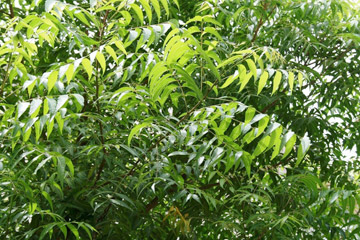Neem-based items have much potential
by Shari Jayawardhana
What if there were a tree growing in your backyard that could cure
disease, fertilise soil, keep pests off crops and solve the
environmental crisis? It might sound too good to be true, but the good
news is, there is such a tree - and its none other than the Neem Tree (Margosa,
Kohomba).
 Neem is best known for its ability to relieve a range of skin
conditions, naturally and without side effects. Neem is best known for its ability to relieve a range of skin
conditions, naturally and without side effects.
It's not only skin conditions that neem treats though: it boosts the
immune system, purifies the blood, and its oil can keep hair shiny,
healthy and delays greyness.
It is also used to treat malaria, diabetes, cardiovascular disease,
haemorrhoids and fever - to name just a few.
In Sri Lanka, it is quite common to see cosmetics and beauty products
such as soaps, face wash, face masks, shampoos and lotions made out of
Neem.
Neem as a natural pesticide
Neem oil has been found to be very effective on insects. Unlike
chemical insecticides, Neem works on the insect's hormonal system and
not on the digestive or nervous system, therefore, it does not lead to
development of resistance in future generations.
Neem oil, derived from the neem tree (Azadirachta indica ) contains
several chemicals, including "azadirachtin", which affects the
reproduction and digestive process of a number of important pests and
act as repellent also.
About 200 species of insects are known to be controlled by Neem. The
eco-friendly attributes of Neem make it suitable for Integrated Pest
Management programs.
In Sri Lanka, the Neem seed kernel water extract and Neem based
commercial products (Neemal, Neemazol - F and Neem poonac) have shown
efficacy against the cabbage leaf eating caterpillar, brinjal fruit
borer and tomato fruit borer.
Soil incorporation of Neem and poonac effectively controls the root
rot nematodes on vegetable crops such as tomato, cucurbits, beet and
carrot and ornamental plants. Survey on Neem use for cabbage caterpillar
in Sri Lanka has indicated that farmers were able to reduce their total
cost of pest control by 44 percent and pesticide cost by 92 percent
compared to those who used chemical pesticides. Farmers also realised
that Neem was less costly and non-toxic to humans. Farmers observed that
Neem effectively controlled pests with fewer applications and resulted
in quicker pest control.
Neem has found to be useful in increasing the crop production in
coconut plantations in Sri Lanka. A broad spectrum botanical Insecticide
derived from the Neem tree seed kernel called NeemAzal has been proven
to be effective in combating the coconut mite, Aceria guerreronis (Acari
Eriophyidae) which is one of the most serious and intractable pests of
coconut in the world.
Neem is also used as organic fertiliser as it has more Nitrogen,
Potassium, Phosphorous, Calcium and Magnesium than the farm yard manure.
It minimises the requirement of Nitrogen in crop production and hence
reduces the cost of fertiliser application. It protects the soil during
droughts and adverse weather conditions and is known to increase crop
yields.
Solution for environmental problems
There are many environmental benefits for growing Neem trees: it as
it acts as a flood control, reduces soil erosion and lessens salination.
Neem has the potential to avert environmental crisis in Sri Lanka as it
can be successfully used for rehabilitation of degraded ecosystems and
waste lands. Neem is highly recommended for the reforestation of the Dry
Zones in Sri Lanka particularly in the Northern Province due to many
reasons: Neem is a hardy tree which thrives under harsh weather
conditions such as extreme heat. It has a strong root system that can
extract nutrients and moisture from poor soils. It is easy to propagate
and once it has been established it needs very little attention or care.
It is a perennial that can be regularly harvested for decades. Neem also
helps in restoring and maintaining soil fertility which makes it highly
suitable in agro-forestry.
Neem and the rural economy
Neem can be extremely beneficial in boosting the rural economy in Sri
Lanka. The Timber Corporation of Sri Lanka should promote the use of
Neem wood for furniture.
It can be used as a substitute for true mahogany as it belongs to the
Mahogany family. A really useful property of Neem timber is that it
repels pests such as termites.
Sri Lanka could cash in on the growing demand in European countries
for household furniture made out of light-coloured Neem wood.
The majority of rural farmers in Sri Lanka manage on limited
resources and they cannot afford the high cost of synthetic pesticides.
Therefore, the Agricultural Department should take steps to
demonstrate and convince farmers about the possible benefits of using
Neem in agriculture.
In developing Neem based products, there is room for innovation. Neem-based
items have a lot of potential in the world market.
It is recommended that a separate institution be set up for
researching and promoting Neem based merchandise, and that these value
added products are manufactured under rural industries. |

